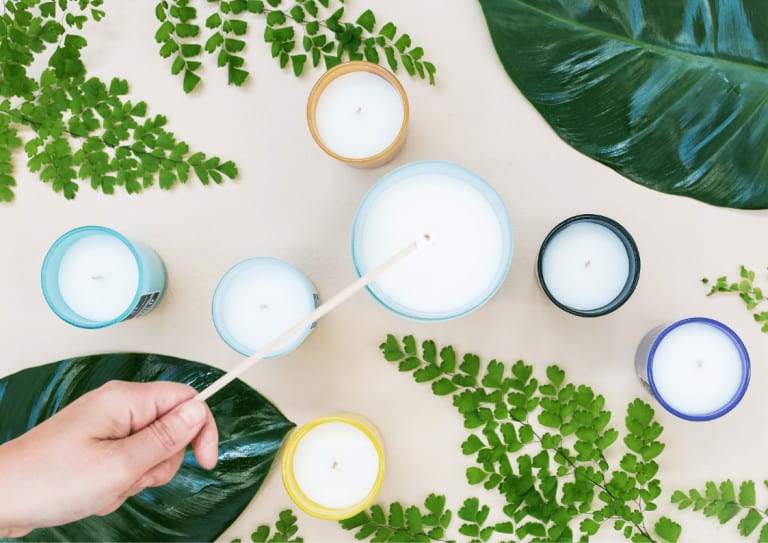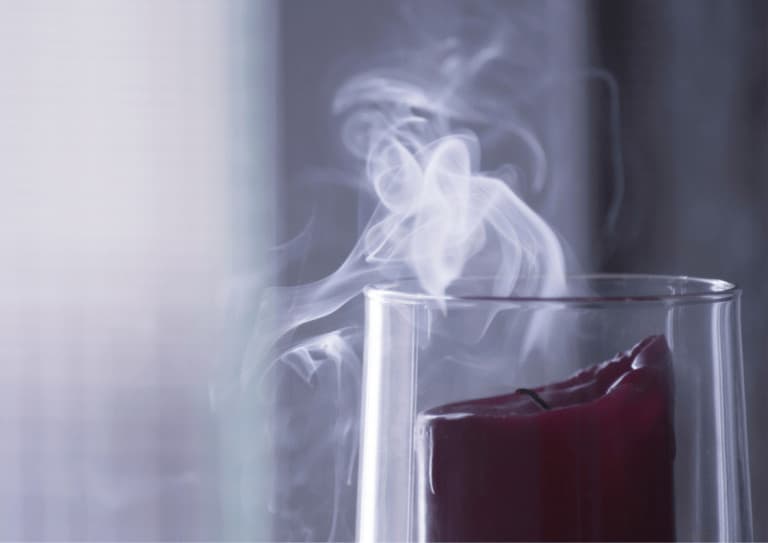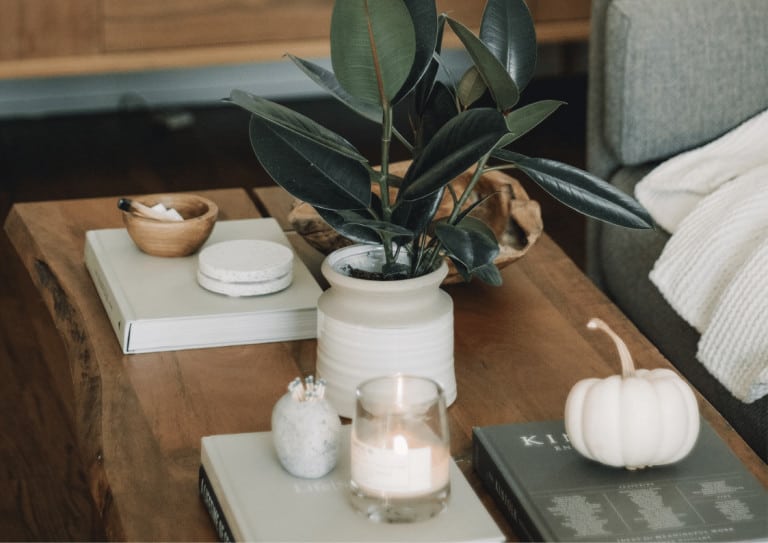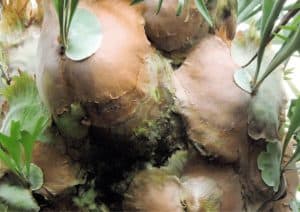Are Candles Harmful To Houseplants? (Heat, Soot & Scent)
-
Chris Dosser
- January 2, 2022
If you buy something using the retail links in our articles, sometimes we earn a small affiliate commission. This does not impact the products we recommend.
If you recently started lighting the wicks of your scented jars of wax and noticed that your houseplants are losing a bit of their perkiness or color, your candles may be to blame.
Lower-quality candles that include benzene in their wax can directly impact the health and wellness of your houseplants by displacing carbon dioxide needed for photosynthesis whilst soot and radiant heat from any candle positioned too close to foliage will have the potential to smother and scorch the greenery of any plant.
There are however a few quick and easy things you can do to minimize potential damage, these include:
- Providing adequate ventilation around burning candles
- Positioning the candle away from beneath any overhanging foliage
- Minimizing the production of candle soot through extinguishing with wax
- Knowing your candle ingredients to avoid unwanted chemicals
This post will cover the impact that candle soot, inadequate ventilation and poor-quality ingredients can have on the health of your houseplants and how to overcome these issues.

How to stop harming your indoor plants with candles
If you cannot live your life without a lit wick, there are a few things that you can do to ensure the well-being of your houseplants (and yourself).
Adequate ventilation will disperse unwelcome gases and heat
A constant flow of air through your office space or room will ensure that your plants are not severely impacted by the chemicals released into the air by your scented candles or their soot.
Houseplants are fantastic at reducing the concentrations of volatile organic compounds, but can only remove small quantities before they become overwhelmed (benzene and toluene are explored in more detail below).
Open windows, if possible, or use an air filtering device to ensure that your plants are getting adequate ventilation. This will help distribute compounds released by the wax and soot as well as heated air from around your house plants leaves.
Houseplants that have delicate foliage which thrive in humid, shady environments (i.e. maidenhair fern or arrow syngonium) have little protection against direct heat, so keeping a lit candle close to them can easily result in damage their tissues.

Minimize candle soot to protect your houseplants
Beyond having adequate ventilation, there are other means by which you can reduce the volume of soot produced by your scented candles.
Soot is produced from incomplete combustion of the carbon within the wax and oxygen in the air. There is too much airflow crossing the candle flame. It is also a by-product of a too-long wick (more than ten to fifteen millimeters).
You can avoid excess soot when burning your candles by ensuring that the candle is not directly beneath an active area of airflow and by using wider-mouthed jars for your candles.
Tall, narrow candle votives actually create an environment conducive to excess soot production.
Soot can damage your plants during the burning of your candles and when you snuff the flame. You can minimize the amount of soot dispersed when putting out your candle with the following tips:
- Never snuff the flame of your candle by smothering the supply of oxygen (don’t extinguish your candle by lidding it)
- Keep your wick trimmed to minimize the soot-producing ember size
- Put candles out by dipping the wick into the melted wax
- Extinguish candles next to an opened window to allow for soot to escape
Keep in mind that the above tips will only be effective if you are burning a high-quality candle — which, coincidentally, is the next topic on our list.

The ingredients in poor quality candles can negatively impact houseplants
When purchasing scented candles that will be lit close to houseplants, you should be aware of three main things:
- The type of wick the candle has
- The type of wax the candle uses
- What is giving your candle it’s fantastic scent
Candle wicks should be made of either cotton or paper. Unfortunately, many non-U.S. manufacturers will include lead cores in their candle wicks. Though this practice is illegal in many countries, some imported candles may still have leaded-core wicks.
Paraffin wax is also a common ingredient in low-quality candles. Paraffin is a waste by-product of petroleum and has been known to release potentially carcinogenic, toxic chemicals when burned. Not desirable for any living organism.
To care for your houseplants there are many other non-toxic wax options to choose from when it comes to candles. These options include:
- Vegetable wax
- Coconut wax
- Soy wax
- Beeswax
- Palm wax
Choosing the right source of the amazing scent of your candle is another issue. Synthetic fragrances can actually pose health hazards not only to your plants but to you.
Choosing a high-quality candle whose scent comes from a natural source, such as pure essential oils, is best. You will want to avoid candles whose labels include words such as parfum, fragrance, or phthalate.
There are two main toxic chemicals found in cheaply made candles, benzene and toluene, that can directly impact your health and the health of your plants.
Benzene is a solvent commonly found in paints and oils and has been demonstrated to inhibit photosynthetic pathways and displace other gases (carbon dioxide and oxygen) needed for the plant to generate energy.
Toluene is found in soot produced by lit candles. It can negatively impact the function of our central nervous system and restrict normal respiration and photosynthesis in houseplants.
Knowing what to look for when purchasing a high-quality candle will not only benefit the health and well-being of your houseplants but your health as well.
Final thoughts
If you are a candle-loving, plant-enthusiast who cannot go without either, there are steps you can take to ensure that you have both the pleasing scent and relaxing ambiance from your candles and the happiness and increased productivity from your plants.
Take time to become knowledgeable about the ingredients of your candles and avoid buying ones that include benzene or toluene. Ensure that your office has ample ventilation, either with an opened window or an air filtering device to reduce the impact that soot can have on your plants (and on you).
If you do your part by purchasing natural, high-quality candles, you should have no problem getting the best of both worlds.

Chris Dosser
Co-Founder of Eden Indoors
Chris is a self-taught horticulturist with over a decade of experience caring for houseplants and creating lush, thriving indoor oases. He specializes in Monstera, and by self admission has a serious problem with buying and propagating rare indoor plants!
Similar Posts
My Staghorn Fern Shield Frond Is Brown – Is This Normal?
Leaves and foliage turning brown is often a sign of danger for a plant....however not always! Case in point being the shield fronds of a Staghorn fern.
What Is A Pebble Tray For Houseplants? (With Infographic)
In terms of caring for your indoor plants, using a pebble tray is about as simple as it gets yet the method can be really effective at improving the health of some...



